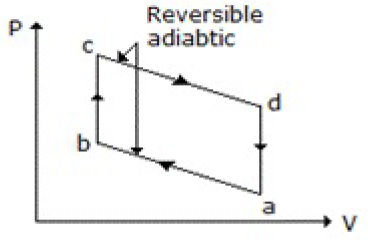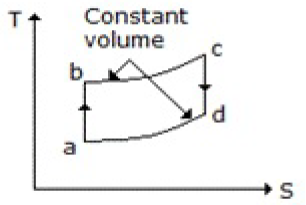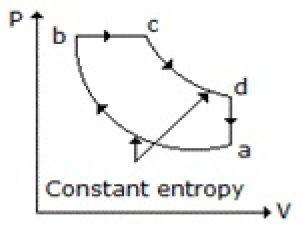Joule-Thomson co-efficient for a perfect gas is
Zero
Positive
Negative
None of these
Correct Answer :
A. Zero
Related Questions
In any spontaneous process,
Only F decreases
Only A decreases
Both F and A decreases
Both F and A increase
Which of the following diagrams does not represent an Otto cycle?



None of these
For an ideal gas, the activity co-efficient is
Directly proportional to pressure
Inversely proportional to pressure
Unity at all pressures
None of these
At normal boiling point, molar entropy of vaporisation is __________ Joule/K°.mole.
72
92
142
192
Pick out the Clausius-Clapeyron equation from the following:
dP/dT = ΔH/TΔV
ln P = - (ΔH/RT) + constant
ΔF = ΔH + T [∂(ΔF)/∂T]P
None of these
Which is not a refrigerant?
SO2
NH3
CCl2F2
C2H4Cl2
A refrigerator may be termed as a
Heat pump
Heat engine
Carnot engine
None of these
The expression, ΔG = nRT. ln(P2/P1), gives the free energy change
With pressure changes at constant temperature
Under reversible isothermal volume change
During heating of an ideal gas
During cooling of an ideal gas
Pick out the wrong statement.
The values of (∂P/∂V)T and (∂2P/∂V2)T are zero for a real gas at its critical point
Heat transferred is equal to the change in the enthalpy of the system, for a constant pressure, non-flow, mechanically reversible process
Thermal efficiency of a Carnot engine depends upon the properties of the working fluid besides the source & sink temperatures
During a reversible adiabatic process, the entropy of a substance remains constant
Which of the following units is not present in both the vapor compression refrigeration system and absorption refrigeration system?
Expansion valve
Condenser
Refrigerator
Compressor
Claude gas liquefaction process employs cooling
At constant pressure
By throttling
By expansion in an engine
None of these
Any substance above its critical temperature exists as
Saturated vapour
Solid
Gas
Liquid
With increase in reduced temperature, the fugacity co-efficient of a gas at constant reduced pressure
Increases
Decreases
Remain same
Decreases linearly
Which of the following exemplifies an adiabatic process?
Melting of ice
Condensation of alcohol vapor
Sudden bursting of a cycle tube
Evaporation of water
Heat pump
Accomplishes only space heating in winter
Accomplishes only space cooling in summer
Accomplishes both (A) and (B)
Works on Carnot cycle
The temperature at which both liquid and gas phases are identical, is called the __________ point.
Critical
Triple
Freezing
Boiling
If different processes are used to bring about the same chemical reaction, the enthalpy change is same for all of them. This is __________ law.
Hess's
Kirchoff's
Lavoisier and Laplace
None of these
Free energy, fugacity and activity co-efficient are all affected by change in the temperature. The fugacity co-efficient of a gas at constant pressure ____with the increase of reduced temperature.
Decreases
Increases
Remains constant
Decreases logarithmically
Pick out the wrong statement.
At constant pressure, solubility of a gas in a liquid diminishes with rise in temperature
Normally, the gases which are easily liquefied are more soluble in common solvents
The gases which are capable of forming ions in aqueous solution are much more soluble in water than in other solvents
At constant pressure, solubility of a gas in a liquid increases with rise in temperature
As the time is passing, entropy of the universe
Is increasing
Is decreasing
Remain constant
Data insufficient, can't be predicted
Which of the following decreases with increase in pressure?
Melting point of ice
Melting point of wax
Boiling point of liquids
None of these
Absorption/evolution of heat during conversion of a substance from one allotropic form to another is termed as the heat of
Sublimation
Fusion
Transition
Vaporisation
If an ideal solution is formed by mixing two pure liquids in any proportion, then the __________ of mixing is zero
Enthalpy
Volume
Both 'a' & 'b'
Neither 'a' nor 'b'
(∂T/∂P)H is the mathematical expression for
Specific heat at constant pressure (Cp)
Specific heat at constant volume (Cv)
Joule-Thompson co-efficient
None of these
In vapour compression refrigeration system, if the evaporator temperature and the condenser temperatures are -13°C and 37°C respectively, the Carnot COP will be
5.2
6.2
0.168
Data insufficient, can't be found out
The number of degree of freedom for an Azeotropic mixture of ethanol and water in vapourliquid equilibrium, is
3
1
2
0
Which of the following is a thermodynamic property of a system?
Concentration
Mass
Temperature
Entropy
Charles' law for gases states that
V/T = Constant
V ∝ 1/T
V ∝ 1/P
PV/T = Constant
Partial molar free energy of an element A in solution is same as its
Chemical potential
Activity
Fugacity
Activity co-efficient
Melting of ice exemplifies a/an
Adiabatic process
Endothermic reaction
Exothermic reaction
Process involving a chemical reaction
